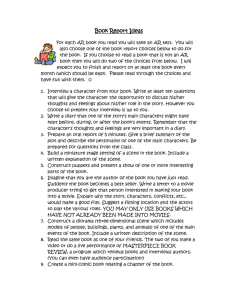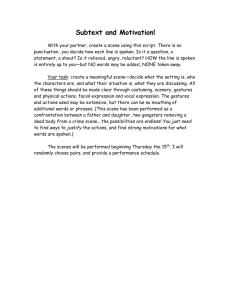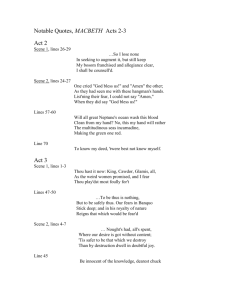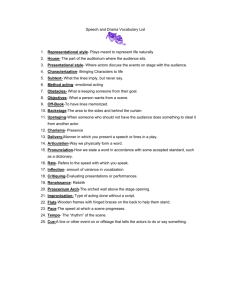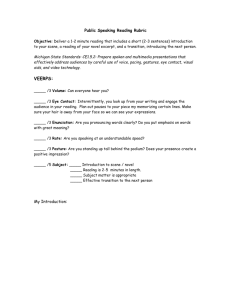821ъ±Є∑C8&»%O CN.CO %CJ
advertisement
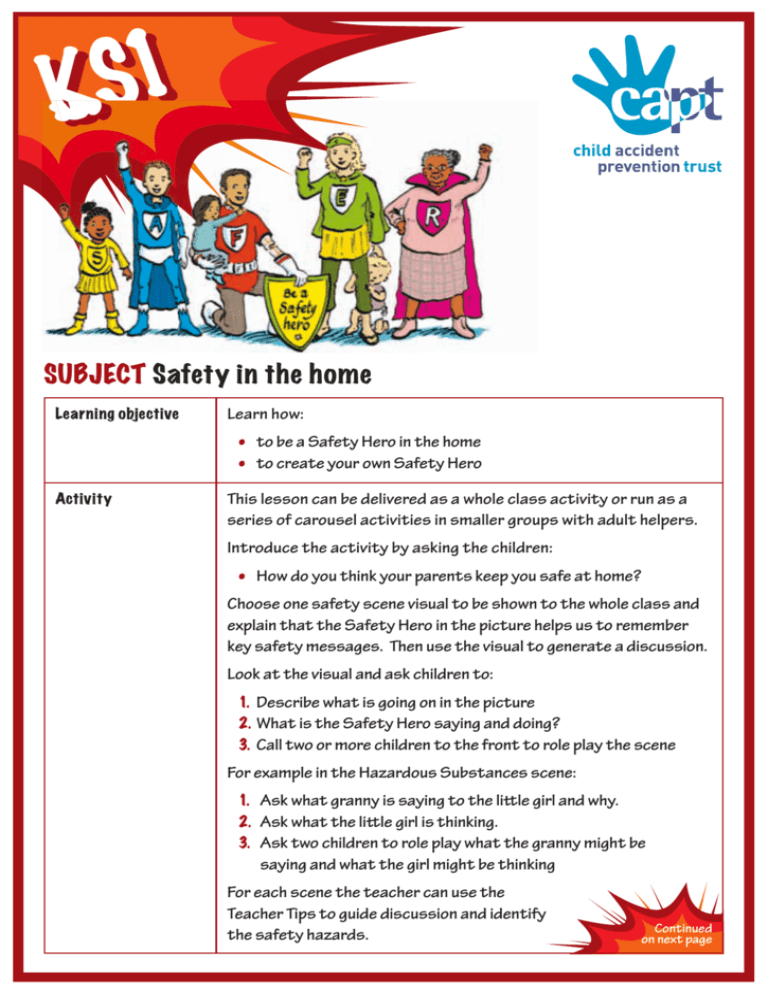
#
#
"
"
!!
56789:;(5#<"-0(&%(-="(=)>"
!"#$%&%'()*+",-&."
Learn how:
•
•
/,-&.&-0
to be a Safety Hero in the home
to create your own Safety Hero
This lesson can be delivered as a whole class activity or run as a
series of carousel activities in smaller groups with adult helpers.
Introduce the activity by asking the children:
•
How do you think your parents keep you safe at home?
Choose one safety scene visual to be shown to the whole class and
explain that the Safety Hero in the picture helps us to remember
key safety messages. Then use the visual to generate a discussion.
Look at the visual and ask children to:
( 12( D
( escribe what is going on in the picture
( 32 What is the Safety Hero saying and doing?
( 42 Call two or more children to the front to role play the scene
For example in the Hazardous Substances scene:
12 Ask what granny is saying to the little girl and why.
32 Ask what the little girl is thinking.
42 Ask two children to role play what the granny might be
saying and what the girl might be thinking
For each scene the teacher can use the
Teacher Tips to guide discussion and identify
the safety hazards.
Continued
on next page
;="(>#&%('$)?@(
#,-&.&-0A
12( (Divide children into 5 groups.
32( (Put one visual on each table.
42( (As a group, children have 2-3 minutes to discuss what is
happening in the scene before moving onto the next visual.
B2( (When finished, bring children back as a class and ask them to
feed back on each safety scene. The teacher can use the Teacher
Tips to help bring out the key safety messages for each scene.
C2( (Ask the children to think about one safety action they can do to
prevent an accident.
D2( (Hand out certificates and each child to complete their own
Safety Hero Certificate with their name and one Safety Hero
action. For example:
EF(G&HH(>#I"(J?$"(K)J&"(&J(#HG#0J(J-$#@@"L(&%-)(="$(=&'=(,=#&$M
EF(G&HH(#JI(#%(#L?H-(#-(=)>"(-)(,=",I(-="(J>)I"(#H#$>M
9N-$#(#,-&.&-0
Ask the children to draw a Safety Hero of their own and describe
their powers.
OH"%#$0
Each child to read out their name and their pledged safety action.
5?,,"JJ(,$&-"$&#
I am now a Safety Hero and can talk about at least one way to
prevent an accident in the home.
F:;(#%L()-="$(
$"J)?$,"J
12( 5 individual safety scenes depicting safety hazards to discuss.
• Falls scene
• Hazardous substances scene
• Burns and scalds scene
• Water safety scene
• Fire safety scene
32( (Teacher tips on each safety scene outlining the safety hazards
and questions to prompt discussion.
42( (Safety Hero Certificate printed out for each child to complete at
the end of the session.
P)?%L#-&)%(Q((
K","@-&)%(0"#$(
Guided by Teaching Assistant or Class Teacher, the lesson can be
differentiated for a Foundation / Reception class by using the home
corner as a focus for role play and identification of potential safety
hazards at home.
55OO!!//;;
$%&&'(')*+*(
$%&&'(')*+*(
,%-%./01'(
,%-%./01'(
'12'3%+)*'(
'12'3%+)*'(
')*+*
')*+*
41.+'(%+/(
41.+'(%+/(
')%&/'(')*+*
')%&/'(')*+*
5%3*.((
5%3*.((
'%6*37(')*+*
'%6*37(')*+*
$8.*((
$8.*((
'%6*37((
'%6*37((
')*+*(
')*+*(
'
*
)
$
(
'
&
%
$
#
!"
++$$''""
This is to certify that
has pledged to
complete the following:
to become an official
!"#$%&'()*+,&-**.&
'()*+,&/*01
Signed:
Katrina Phillips, Chief Executive
Child Accident Prevention Trust
R51(;"#,="$(;&@J(
!"JJ)%(OH#%A(5#<"-0(&%(-="(=)>"
:=&HL$"%SJ(#*&H&-&"J
4-7 year olds are still learning about how to
spot danger. Their actions are impulsive and
they have a tendency to overestimate their
own abilities, so adult guidance or supervision
is still needed.
Their abilities and actions – often when they
are trying to be helpful – may have an impact on
the safety of younger siblings. Children under 5
are particularly vulnerable to serious accidents
at home. Older children may be able to play a
part in keeping younger children safe at home.
P#HHJ(J,"%"
Toddler risks falling from a high chair
The scene depicts a potential fall from a
high chair for a toddler. What types of falls
do the children think can happen to children
of their own age? What safety tips can
they think of to help prevent a serious fall
at home or out and about?
Falls from the top of the stairs, bunk beds,
windows, balconies and from play equipment
are the most common causes of serious
accidents for this age group. Children may
be tempted to climb over safety gates and
balconies, jump off the top bunk, lean too far
from an open window or use play equipment
dangerously as they test their abilities.
•
•
•
•
Discourage children from running or
playing on the stairs.
Explain the dangers of playing or
fiddling with windows.
Help the children understand the
danger of jumping from great heights.
Help children to identify safe but fun
places to play.
7?$%J(#%L(J,#HLJ(J,"%"
Scene depicts a toddler about to knock a hot
drink over himself
What do the children think might happen if
the toddler knocks the hot drink over himself?
Why does the toddler’s mum looks so worried?
What other things at home can the children
think of that might cause a burn or scald?
A hot drink can scald a baby or toddler 15
minutes after it’s been made, hair straighteners
get as hot as an iron and water from a hot tap
can badly burn skin within seconds.
At this age, children are very keen to copy or
help the adults around them and want to do
tasks like a grown-up. Children at this age
can carry out simple household jobs and be
taught how to do things safely if parents
think they are ready in terms of their ability
and confidence.
Tasks involving hot food and drink need to be
carefully supervised, matches and lighters
are still dangerous as they can lead to house
fires and, as children of this age can now climb
into the bath independently, they are at risk
of scalds if the bath water is too hot.
•
•
•
•
Remind the children not to pick up a
hot drink that an adult has made for
themselves.
Discourage children from touching hair
straighteners lying around.
Encourage children to ask an adult to
check the bath water temperature before
they jump in.
Encourage children not to touch kettles
or cooking pans at the front of the
kitchen work surface or hot plate.
R51(;"#,="$(;&@J(((Continued)
!"JJ)%(OH#%A(5#<"-0(&%(-="(=)>"
P&$"(J#<"-0(J,"%"
An older sibling uses a broom to test the smoke
alarm
The scene demonstrates how older children
can start to think about what they can do to
keep themselves and their families safe in the
home. What is happening in the picture? What
is the older child doing with the broom? Why is
the younger child covering his ears?
Every year, a small number of children die in
house fires, usually from breathing in
poisonous smoke rather than from burns.
•
•
•
Explain why it is important for every home
to have working smoke alarms, upstairs
and downstairs.
Ask children if they know what the sound
of the smoke alarm means and if they help
with testing the alarms in their home.
Encourage children to think about how
their family would escape, if a fire did
break out.
V#-"$(J#<"-0(J,"%"
A father empties out a paddling pool
The scene shows a father emptying out
a paddling pool at the end of the day. Do
the children know why this is important?
What might happen if they or a younger
sibling played with the water in the pool
unsupervised? Can the children identify
other places like garden or park ponds, lakes
or canals that it would be unsafe to play
near?
T#U#$L)?J(J?*J-#%,"J(J,"%"
Granny moves cleaning products out of reach
The scene shows a granny moving a bottle
of household cleaner out of reach. Do they
children know why this is important? What
might happen if the little girl swallowed some
of the cleaning liquid? What is granny saying to
the little girl and what is the little girl thinking?
Children within the 4-7 age group will have
some understanding of what is and what is
not food or drink, and accidental poisoning in
this age group is rare. However, they may still
mistake items like liquitabs or vitamins for
sweets, brightly coloured chemical bottles
for soft drinks or poisonous berries for
redcurrants or blackberries.
•
•
•
•
•
Remind children about the danger of
drinking or eating anything if they don’t
know what it is.
Ask the children to make sure they tell
an adult if they see their younger siblings
doing the same.
4-7 year olds may be more confident in
water and whilst some will have started
to learn to swim, this is no guarantee
of safety in water. Explain that children
must never play in or near water without
the supervision of an adult or a trained
life guard.
Help them understand why they should
never leave a younger sibling in the bath
or paddling pool by themselves.
Help children learn about beach safety –
see www.rnli.org.uk for information.
R51(;"#,="$(;&@J(((Continued)
!"JJ)%(OH#%A(5#<"-0(&%(-="(=)>"
W)$"(&%<)$>#-&)%
• Download the Child Safety Week ideas booklet for safety facts, tips and activity ideas:
999:);8&/'%6*379**<:0.=:1<
• Visit the Child Accident Prevention Trust’s website for more safety advice and information:
999:)%>3:0.=:1<?'%6*37@%/A8)*
• Visit the Fire Kills website for information on fire safety: 999:=0A:1<?B.*<8&&'
• CAPT’s Accidents and child development guide explains the serious accidents that
happen at different stages of a child’s development, the practical steps recommended
to prevent them, plus simple safety tips. Visit CAPT’s online shop:
999:)%>3:0.=:1<?';0>?%))8/*+3'@%+/@);8&/@/*A*&0>C*+3



